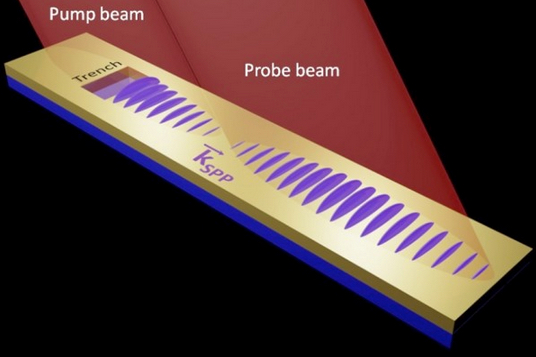Light-speed interconnects may lead to ultra-high-speed computers
August 31, 2015

Specially designed, extremely small metal structures can trap light. Once trapped, the light becomes a confined wave known as surface plasmons. The surface plasmons are represented here by the blue waves, which begin at the pump beam and are detected 250 micrometers away by the probe beam, traveling at almost as fast as light through the air. (credit: Hess et al./Nano Lett.)
Light waves trapped on a metal’s surface (surface plasmons) travel farther than expected, up to 250 micrometers from the source — which may be far enough to create ultra-fast nanoelectronic circuits, researchers at Pacific Northwest National Laboratory have discovered.
Future computer circuits could use this phenomenon as interconnects between nanocircuits. Because a surface plasmon travels at near the speed of light, computer circuits with this technology could operate at much faster speeds than current electronics, which use copper wires.
In their experiments, the team applied two laser pulses to a gold sample surface: the first laser pulse, the “pump,” generates the surface plasmon; the second pulse, the “probe,” detects the surface plasmon after a short time delay.
By continuously tuning the time delay between the pump and probe pulses, the team monitored the motion of the plasmon on the gold surface. They captured the confined waves propagating on video, helping to directly extract details such as wavelength and speed. They also determined that a propagating plasmon can be detected at least 250 micrometers (millionths of a meter) away from the generation source — far enough to be useful in electronic circuits.
This finding may lead to ultra-fast computers and devices in the biological, health, and energy arenas.
Abstract of Ultrafast Imaging of Surface Plasmons Propagating on a Gold Surface
We record time-resolved nonlinear photoemission electron microscopy (tr-PEEM) images of propagating surface plasmons (PSPs) launched from a lithographically patterned rectangular trench on a flat gold surface. Our tr-PEEM scheme involves a pair of identical, spatially separated, and interferometrically locked femtosecond laser pulses. Power-dependent PEEM images provide experimental evidence for a sequential coherent nonlinear photoemission process, in which one laser source launches a PSP through a linear interaction, and the second subsequently probes the PSP via two-photon photoemission. The recorded time-resolved movies of a PSP allow us to directly measure various properties of the surface-bound wave packet, including its carrier wavelength (783 nm) and group velocity (0.95c). In addition, tr-PEEM images reveal that the launched PSP may be detected at least 250 μm away from the coupling trench structure.